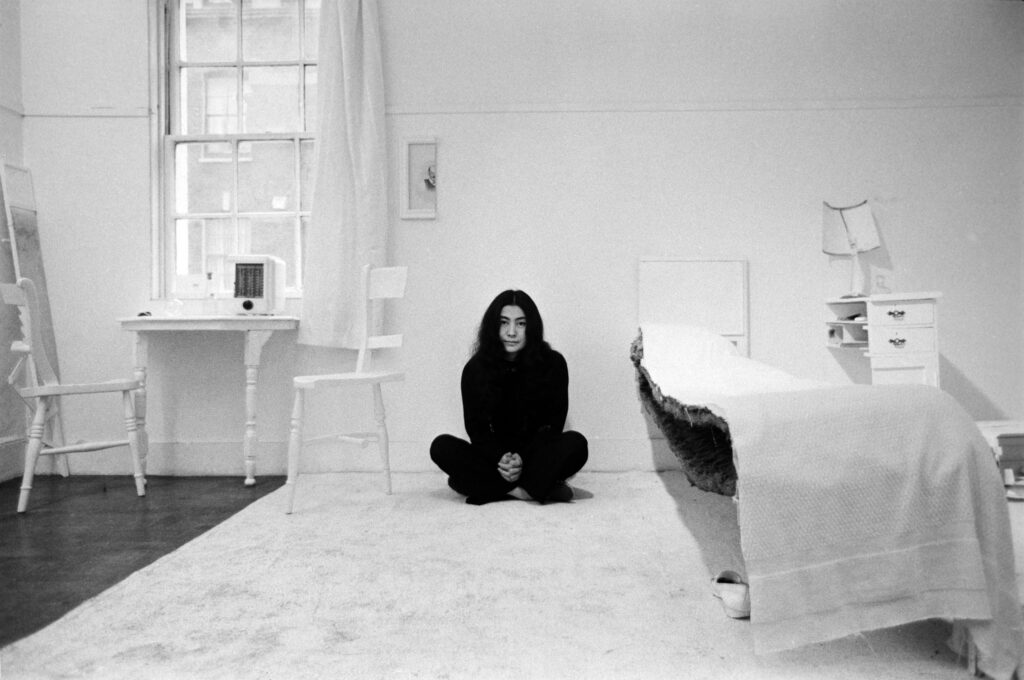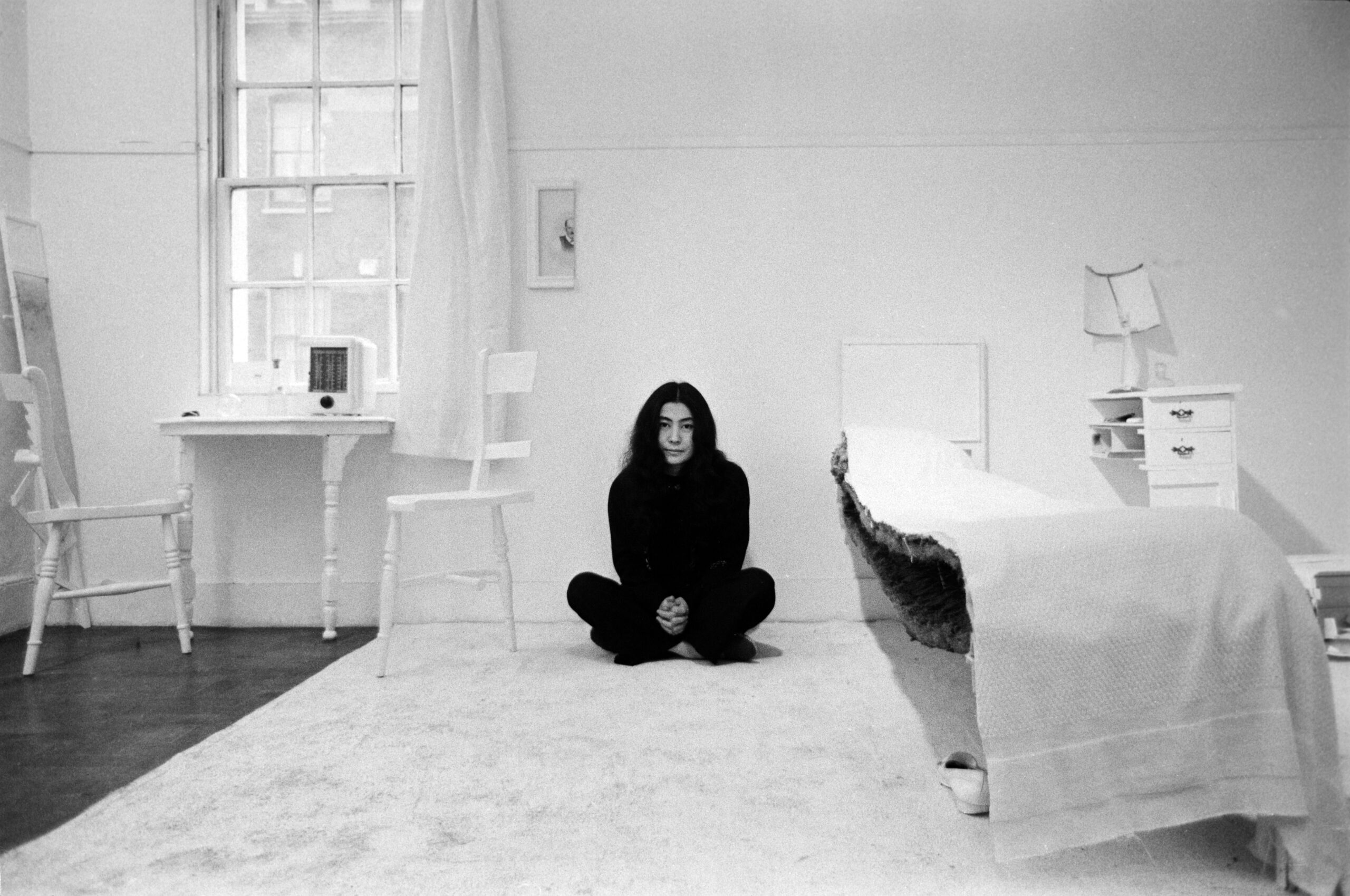
Yoko Ono, Half-A-Room, from Half-A-Wind Show, Lisson Gallery, London, 1967. Photograph by Clay Perry, courtesy of Tate Modern and Yoko Ono.
Recently, I found myself at the Tate Modern in London, accompanied by my youngest daughter, to see Music of the Mind, a retrospective of the work of Yoko Ono: her drawings, postcards, films, and musical scores. Accompanied is perhaps too easy a word. When told my daughter I wanted to go, she said, “Really?” “Yes,” I said. “Really.”
A myth about Yoko Ono is that she came from nowhere and became a destroyer of worlds. The truth is otherwise. Yoko Ono—now ninety-one—was born in 1933, in Tokyo. Her father was a successful banker and a gifted classical pianist; her mother an art collector and philanthropist. Ono attended a progressive nursery school where the emphasis was on music: the children were taught perfect pitch and encouraged to listen to everyday sounds and translate them into musical notes. In 1943, she and her brother were evacuated to the countryside. Basic provisions were scarce. For hours, they lay on their backs looking at the sky. They said to each other: “Imagine good things to eat. Imagine the war is over.” She returned to Tokyo in 1945. She was president of her high school drama club; in a photo taken at the time, her hair is bobbed and she is wearing what looks like a cashmere sweater set. At Gakushuin University, she was the first female student to major in philosophy. Her family relocated to Scarsdale, in Westchester County; she enrolled in Sarah Lawrence College, where she studied music. After three years, she dropped out and moved to New York, supporting herself by teaching traditional crafts at the Japan Society. In 1960, she rents a loft downtown, at 112 Chambers Street, and begins to host musical performances.
Word gets around. John Cage plays. Marcel Duchamp is in the audience. Peggy Guggenheim drops by. Ono is twenty-six, twenty-seven years old—a member of a loose band of international artists who operate under the name Fluxus, including Joseph Beuys and Nam June Paik. She rejects the term performance art; instead her works are often a series of instructions, by which the viewer can construct or imagine or catalog their own perceptions: art as collaboration. At the Tate, a series of postcards was tacked to the wall, printed with multiple-choice statements such as these:
1) I like to draw circles.
dislike2) I have always drawn circles well.
never3) I am a better circle-drawer now.
was in the past.
when I was ____ (age).
Some other instructions, as in Painting to Let the Evening Light Go Through:
Hang a bottle behind a canvas.
Place the canvas where the west light comes in.
The painting will exist when the bottle creates a shadow on the canvas, or it does not have to exist.
More instructions, in Painting to Be Constructed in Your Head:
Go on transforming a square canvas in your head until it becomes a circle.
Ono writes, “I remember Isamu Noguchi, stepping on Painting To Be Stepped On with a pair of elegant Zohri slippers.” In 1961, Works by Yoko Ono is performed at Carnegie Recital Hall (participants include the choreographers Trisha Brown and Yvonne Rainer). She returns to Japan and performs Cut Piece—the audience is invited to come up onstage and remove pieces of her clothing with a pair of scissors. She moves to London. In 1966, she shows her work at the Indica Gallery. Visitors are handed a magnifying glass and invited to climb a ladder to look at the ceiling, where they can read the word YES, written in tiny letters. Another piece is called Painting to Hammer a Nail In.
Ono recalls:
A person came and asked if it was all right to hammer a nail in. I said it was all right if he pays five shillings. Instead of paying the five shillings, he asked if it was alright for him to hammer an imaginary nail in. That was John Lennon. I thought, so I met a guy who plays the same game I played.
Together Lennon and Ono begin to stage events for peace. Ono’s film showing hundreds of bare bottoms of people in the art world is banned by the British Board of Film Censors; Ono sends them flowers. (Around this time she suggests that, before arguing, people should take off their pants.) WAR IS OVER IF YOU WANT IT appears on billboards in London. By 1969, in March, a year after the My Lai massacre, the U.S. presence in Vietnam has peaked at five hundred thousand servicemen. Knowing that they will be hounded by paparazzi if they take a conventional honeymoon, Lennon and Ono flip the equation: they hold two Bed-ins for Peace—one in Amsterdam, the second in Montreal—and invite the press, who attend in droves, along with Girl Scouts, yoga instructors, and members of the public who bring them brownies. At the Tate exhibition, a film of Lennon and Ono in bed in Amsterdam plays continuously on one white wall. Watching, I notice a number of people rolling their eyes. Others are holding back tears. That month, a photograph of Lennon and Ono’s Montreal Bed-in for Peace appeared in Life magazine. The photograph is black-and-white, but mainly white: white sheets and comforter, white duvet, white room. Ono’s long hair is a black cloud. Lennon is wearing his round metal-frame glasses.
The first time I saw the photograph of the Bed-in for Peace was a week or two after it was published, in a copy of Lifein the waiting room of the ballet studio on Long Island where I attended class two afternoons a week, on Tuesdays and Thursdays. On Wednesday afternoons, I took piano lessons. I was nine years old. I’d arrived early for class, and instead of doing my math homework I’d picked up the magazine to look at. I was wearing pink tights; a pink, short-sleeved leotard; and my long black hair was pinned in a tight bun inside a pink crocheted snood. I knew about the Beatles. In second and third grade, my friend Teddy already played the guitar—he grew up to be the jazz pianist Ted Rosenthal—and at recess we sang Beatles songs in the playground. I played the tambourine. Before school my mother plaited my hair into two long braids; by the time I was twelve, I was yanking off the elastics on the way to school, saving them in my pocket so I could pull my hair back into a ponytail on the way home.
Hanging above a stair landing in my house is one of Lennon and Yoko’s newsprint posters: WAR IS OVER, IF YOU WANT IT: HAPPY CHRISTMAS FROM JOHN AND YOKO. It’s impossible, now, to look at the film or the photograph stripped of the shuddering dark shroud of what would happen eleven years later, in the archway of the Dakota, on West Seventy-Second Street. By then I was twenty, and when I stepped onto the red-and-yellow linoleum in the grimy kitchen in the apartment where I lived off-campus, on a dark, early December evening, getting ready to celebrate a friend’s birthday, the radio was on.
Who knows why certain pictures barely glimpsed—a woman in a train car, the lights of a farmhouse beyond a ridge—leave an afterimage on the mind’s eye? Perhaps, after all, it is better to take off your pants before you start to argue. Perhaps drawing circles is better than drawing straight lines. Perhaps, really, it would be a good idea to give peace a chance. I know that in 1969, while twilight, striped by the half-open venetian blinds, gathered in the parking lot behind the ballet studio where, in an hour, my mother would arrive in our Ford Country Squire station wagon to pick me up, when I looked at that photograph I thought, There is another life.
Cynthia Zarin’s most recent books are Inverno, a novel, and Next Day: New & Selected Poems. Her second novel, Estate, is forthcoming in 2025. She teaches at Yale.

